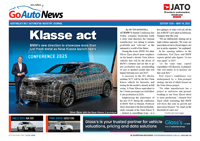Future models - Volvo - VCCFirst look: Volvo carries a swag of ideasEasy access: Pillarless doors are a feature of VCC. Meet Volvo's luxury wagon with a pulse14 Mar 2003 By BRUCE NEWTON NOT everyone was revealing coupes at the Geneva motor show. It was up to Volvo to get more sensible than the rest, showing its new large luxury wagon in the guise of the Versatility Concept Car - or VCC. The shape of the VCC is expected to make it into production as a model mooted to be called the V90, fundamentally a load-hauling equivalent of the large S80 sedan. But the rear-hinged doors and B-pillarless opening will not make it into production for safety reasons. And much of the technology packed under those broad Volvo-esque lines we will not see for up to 10 years. Some of the new ideas built into VCC include:
The engine produces 186kW, yet Volvo claims it consumes no more than 6.5 litres of fuel per 100km. "New innovative engine and transmission technology makes this extremely low figure possible in a 10-year perspective", said the vice-president powertrain engineering at Volvo Car Corporation, Derek Crabb. The base engine features new turbo technology that puts the emphasis on combustion efficiency. This makes greater use of positive boost pressure to clear the combustion chamber of all traces of exhaust gases, thus improving the efficiency rating. The higher compression ratio is on a par with that of a naturally aspirated engine. The engine also features "Direct Start&Stop", which means it cuts out when the car stops, such as at traffic lights or in a stationary line of traffic. When it is time to move off again and the clutch is at the drag point, fuel is injected directly into the engine, which ignites the mixture immediately and gently accelerates the car. Another feature is "Compression Auto Ignition", which harnesses the benefits of a big engine to cut fuel consumption and lower exhaust emissions, however contradictory that might at first sound. The system creates a lean and homogeneous fuel/air mixture that is compression-ignited when the engine is being run on part load and at low to medium revs. And then there is "Automated Shifted Manual", which is a regular manual gearbox that can be shifted automatically with the help of electronically controlled actuators. The driver can use it exactly like a conventional automatic transmission, but since a manual gearbox has a higher efficiency rating than an automatic - because the frictional losses are lower - the end result is lower fuel consumption. The torque loss problem that arises at the moment of shifting in an automated manual gearbox has been solved in the VCC engine with "ED" or Electric Drive. The ED unit, powered by a separate 42-volt battery, also provides extra propulsion power at low revs, before the turbocharger has reached the necessary boost, eliminating the problem of turbo lag. Electric Drive also gives the battery a free charge of energy. When the driver lifts off the accelerator to reduce speed, the car's forward motion powers the ED unit, which in turn recharges the 42-volt battery. This energy can be used, for instance, to drive the VCC for short distances on electric power alone, for example at very low speeds when crawling forward in congested traffic. The ED unit can be installed either on the driven axle or directly on the rear wheels. Combine all that with the use of lightweight materials such as aluminium and carbon-fibre, and the result is a 10 per cent reduction in weight compared with the S80. Inside VCC there's also plenty of radical thinking, including wireless technology, Volvo's take on driver controls of the future, a floating centre console and X-frame ambient light roof panel. There's also the usual lashings of leather in the cockpit as well as brushed aluminium - this is a concept car after all. The all-important luggage area includes a load floor electrically operated via controls mounted on the D-pillar. The floor slides out from the luggage compartment to make the loading procedure more convenient. Beneath the load floor are two storage compartments, one heated and one chilled. The luggage compartment also features a safe-box integrated in the right-hand side panel, while the left side contains a lift-out overnight case, trimmed in matching leather. The luggage cover is also electrically powered. It can be operated from the driver's seat and from the switch in the D-pillar. When not in use, the panels are stored in a hidden recess within the rear seat. |
Click to shareVolvo modelsResearch Volvo Motor industry news |














Facebook Twitter Instagram